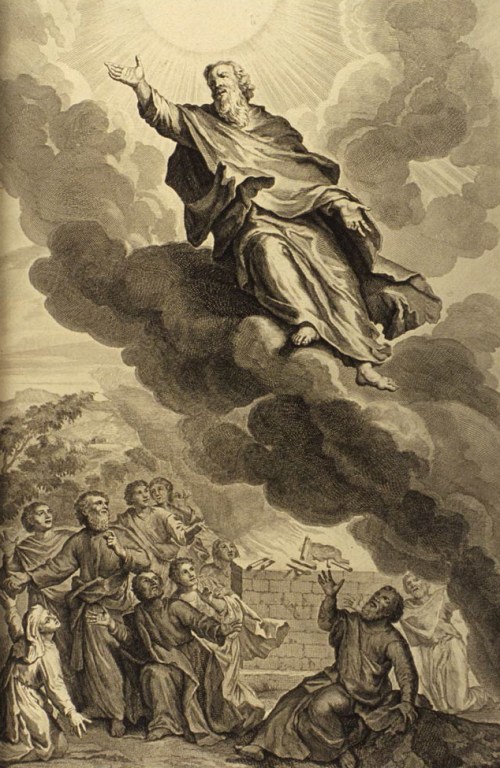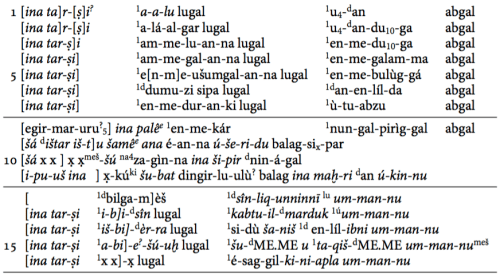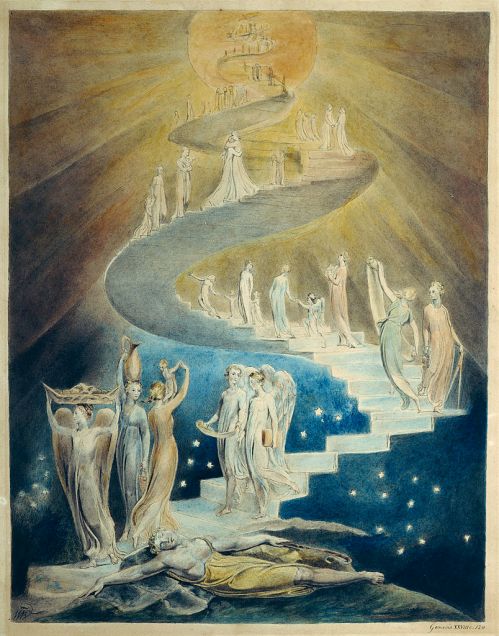Selz: Patriarchs and Sages
“A central figure in the discussion about the alleged Mesopotamian model for the antediluvian patriarchs soon became Enoch, who lived for 365 (364) years and of whom we read in Genesis 5:24: “Enoch walked with God then he was no more, because God took him away.”
The verb lāqah in this context has received numerous comments. Biblical sources offer three interpretations:
a) The liberation of a dead person from the power of the underworld;
b) A final removal from earth (cf. Elijah); or
c) An act of temporal transference, as in dream visions.

Giovanni Lanfranco (1582-1647 CE), Elie nourri par le corbeau, 1624-5 CE. Oil on canvas, held at the Musée des Beaux-Arts de Marseille, Accession number BA 451, photographed by Rvalette.
This faithful photographic reproduction of an original two-dimensional work of art is in the public domain where the copyright term is the author’s life plus 100 years or less.
The name Enoch has found several interpretations: It has been argued that J derived the name from hānaq, “to dedicate” and “to train” which comes close to an interpretation of “the sage” (cf. also Arabic Idris!), and it may well be that the two values attributed to Enoch in Genesis are a “babilistic” interpretation of “a man dedicated to and trained by God.”
In the light of Genesis 4:17 the name was also thought to convey the meaning of “founder,” referring to the eponymous city Enoch. This Enoch is possibly entering the rank of those patriarchs who, according to biblical tradition, were perceived as a sort of cultural heroes.

Gerard Hoet (1648-1733 CE), Illustrators of the Figures de la Bible, P. de Hondt, The Hague, 1728 CE.
God took Enoch, as in Genesis 5:24: “And Enoch walked with God: and he was not; for God took him.” (KJV) illustration from the 1728 Figures de la Bible; illustrated by Gerard Hoet (1648–1733) and others, and published by P. de Hondt in The Hague; image courtesy Bizzell Bible Collection, University of Oklahoma Libraries.
This work is in the public domain in its country of origin and other countries and areas where the copyright term is the author’s life plus 70 years or less.
https://commons.wikimedia.org/wiki/File:Figures_God_took_Enoch.jpg
(Westermann, Genesis, pp. 443-45 suggests that Enoch may refer to the foundation of a city or sanctuary. Westermann writes: “In Israel wurde die Erinnerung daran bewahrt, daß der Städtebau zum dem gehört, was vor und außerhalb der Geschichte Israels geschah. Die Gründung der ersten Stadt gehört der Urgeschichte an” (p. 444).
("In Israel, the memory was preserved because of urban development,
what happened before and outside of history.
The founding of the first city belongs to prehistory.")
Discussing Genesis 4:17 most exegetes remark that it seems unlikely that Kain, the tiller, condemmed to a nomadic life, could be renowned as the founder of a city. In an attempt to harmonize the alleged discrepancies, they even assume that the said founder was originally Enoch (cf. e.g. Westermann, Genesis, p. 443).
With the publication of a Seleucid text from Uruk, W 20030,7 the comparison between Berossos, the Old Testament, and the Sumerian King List reached a new level:

Seleucid text, Uruk, W 20030,7. Published by J.J.A. van Dijk, “Die Tontafeln aus dem Resch-Heiligtum,” in Uruk-Wanka Vorberichte 18 (1962): pp. 43-52, from which this transcription is taken. Also on Samizdat, in Lenzi: The Uruk List of Kings and Sages.
Excerpt from Selz, Of Heroes and Sages, 2011, p. 793.
This document establishes an important link between Berossos’ account of the primeval kings and his story of the sage Oannes.
In this text the names of Mesopotamian rulers are accompanied by names of advisors, sages, the so-called apkallū which play an important role in Mesopotamian iconography and have been known, up until now, chiefly from the so-called Etiological Myth of the “Seven Sages” studied by Erica Reiner in 1961.
(E. Reiner, “The Etiological Myth of the ‘Seven Sages,’” Orientalia 30 (1961): 1-11; eadem, Astral Magic in Babylonia (Transactions of the American Philosophical Society 85.4; Philadelphia: American Philosophical Society, 1995).
(See further S. Parpola, “Mesopotamian Astrology and Astronomy as Domains of the Mesopotamian ‘Wisdom,’” in Die Rolle der Astronomie in den Kulturen Mesopotamiens: Beiträge zum 3. Grazer Morgenländischen Symposium (ed. H. Galter and B. Scholz; Grazer Morgenländische Studien 3; Graz: RM Druck-und Verlagsgesellschaft, 1993), pp. 23-7.)
This list is certainly fictional, it is, however, based on scholarly traditions: the name of the well-known compiler of the standard version of the Gilgamesh Epic, dsîn-liq-unninnī, functions as an apkallu to Gilgamesh himself.
Further, a certain Kabtu-il-Marduk, perhaps referring to the author of the Erra Epic Kabti-ilāni-Marduk, is mentioned as a sage during the reign of Ibbi-Sîn (ca. 2028-2004 BCE), unlucky last king of the Ur III empire.”
Gebhard J. Selz, “Of Heroes and Sages–Considerations of the Early Mesopotamian Background of Some Enochic Traditions,” in Armin Lange, et al, The Dead Sea Scrolls in Context, v. 2, Brill, 2011, pp. 792-4.



